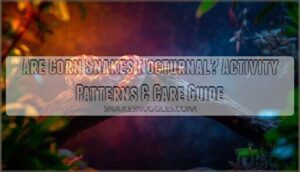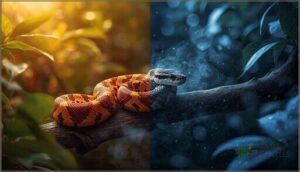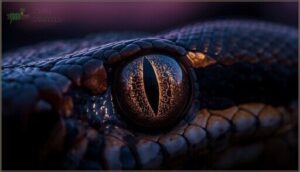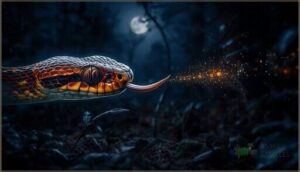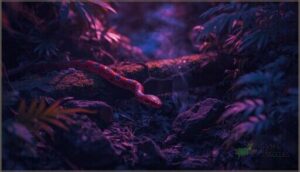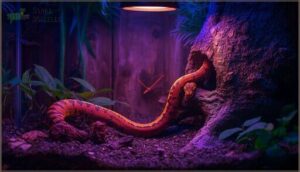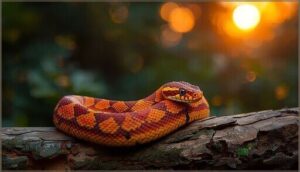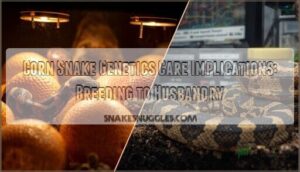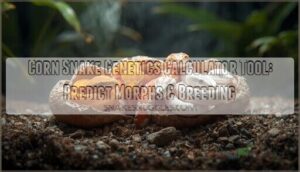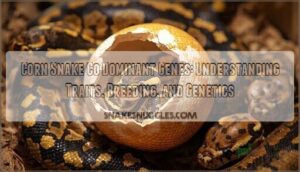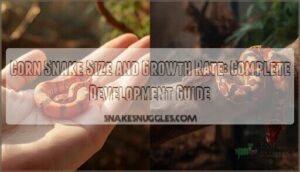This site is supported by our readers. We may earn a commission, at no cost to you, if you purchase through links.
Your corn snake hasn’t moved all day, but the moment you turn off the lights, it transforms into an active explorer. This pattern confuses many new owners who wonder if their snake is sick or simply following its natural rhythm.
The answer isn’t as straightforward as labeling corn snakes nocturnal or diurnal. These snakes operate on a crepuscular schedule, meaning they’re most active during twilight hours when temperatures moderate and prey emerges.
Understanding this behavior pattern isn’t just interesting trivia—it directly affects how you set up their enclosure, when you schedule feeding times, and what times you should avoid handling them for their comfort and health.
Table Of Contents
- Key Takeaways
- Are Corn Snakes Nocturnal?
- Corn Snake Activity Patterns
- Environmental Factors Influencing Activity
- Physiology and Adaptations for Low Light
- Activity Patterns in Captivity
- Implications for Corn Snake Owners
- Frequently Asked Questions (FAQs)
- Are corn snakes active at night?
- Are snakes nocturnal or diurnal?
- Do corn snakes sleep?
- Do corn snakes hunt at night?
- Are corn snakes active at dusk & dawn?
- Do corn snakes need a night light?
- What time of day are corn snakes most active?
- Do corn snakes sleep during the day?
- How to tell if a corn snake is stressed?
- Should I turn my corn snakes light off at night?
- Conclusion
Key Takeaways
- Corn snakes are crepuscular, meaning they’re most active during dawn and dusk rather than being strictly nocturnal or diurnal, though they’ll adjust their patterns based on temperature, season, and prey availability.
- Their eyes contain rod-rich retinas for low-light vision, but they rely more heavily on chemical detection through their Jacobson’s organ when hunting in darkness.
- You should handle your corn snake during early evening hours (1-2 hours after sunset) when their natural activity peaks, keeping sessions brief at 5-10 minutes to minimize stress.
- Creating a proper enclosure with thermal gradients (84-88°F warm side, 78-82°F cool side), a 12-hour light-dark cycle, and turning off bright lights at night supports their natural circadian rhythms and overall health.
Are Corn Snakes Nocturnal?
If you’ve ever watched your corn snake start moving around as the sun goes down, you might wonder if they’re truly nocturnal creatures. The answer isn’t as straightforward as a simple yes or no, and understanding their natural rhythms makes a real difference in how you care for them.
Let’s clear up what nocturnal actually means and tackle some common myths about when corn snakes are most active.
Definition of Nocturnal Behavior
Before you can judge whether corn snakes are truly nocturnal, you need to understand what nocturnal behavior actually means. In behavioral ecology, nocturnal refers to animals that show peak activity during night-time hours, relying on specialized adaptations for low-light conditions. This pattern differs from crepuscular species, active at dawn and dusk, and diurnal animals, which move primarily during daylight.
True nocturnal behavior includes:
- Consistent nighttime activity across seasons and environments
- Specialized sensory systems for moving through darkness
- Peak foraging and movement after sunset and before sunrise
- Reduced daytime activity measured through controlled observations
- Distinct circadian rhythms that align with night cycles
Researchers verify these patterns using motion sensors and direct wild observations, tracking animal sleep cycles and activity over 24-hour periods. Understanding these definitions helps you recognize authentic nocturnal adaptations versus flexible activity patterns that shift with temperature or predator pressure. Scientists also use methodological rigor to assess the validity of their findings in various fields of study.
Common Misconceptions About Corn Snake Activity
Many owners assume corn snakes are fully nocturnal, but that’s not accurate—they’re actually crepuscular, peaking at dawn and dusk.
You might also think captivity guarantees wild-like activity patterns, yet enclosure lighting and feeding schedules can shift their circadian rhythms markedly.
Temperature and environmental influences play larger roles than you’d expect, and in darkness, corn snakes rely more on smell than vision for hunting.
Corn Snake Activity Patterns
Understanding when corn snakes are most active helps you provide better care and know the right times to interact with your pet. These snakes don’t fit neatly into a single category, and their behavior shifts based on several factors throughout the day and year. If you’re new to keeping these reptiles, this beginner’s corn snake care guide covers the essentials for creating a healthy routine.
Let’s look at how corn snakes structure their activity and what influences their daily rhythms. Understanding these seasonal shifts helps when distinguishing corn snakes from similar-looking species that may have different activity patterns.
Crepuscular Vs. Nocturnal Vs. Diurnal
Understanding your corn snake’s activity pattern starts with three key terms. Diurnal species are active during daylight hours, while nocturnal animals move primarily at night. Corn snakes, however, are crepuscular—they peak during twilight at dawn and dusk. Because they’re most active at dawn and dusk, you can enhance their habitat with snake-safe terrarium plants that tolerate the humidity levels corn snakes need.
This twilight activity aligns with their circadian rhythms and environmental adaptation, responding to light cycles that trigger natural animal behavior and hunting instincts.
Typical Daily Activity Cycle
Your corn snake’s daily cycles follow predictable patterns tied to circadian rhythms and environmental cues. You’ll notice activity peaks at dawn and dusk, when these crepuscular hunters emerge from shelter. While they don’t require UVB like diurnal species, maintaining a consistent 12-hour light cycle for your corn snake’s habitat helps regulate their natural biorhythms year-round.
During midday heat, your snake rests in hidden spots, then resumes movement as temperatures drop. While resting, snakes rely on their chemical detection abilities through tongue flicking to stay alert to nearby threats even without visual cues.
This routine includes nocturnal exploration after dark, with some individuals showing brief diurnal activity, creating a flexible pattern that adapts to temperature and light changes.
Seasonal Variations in Behavior
Throughout the year, you’ll observe shifts in your corn snake’s behavior as ambient temperature fluctuations and photoperiod changes drive activity peaks. Warmer months intensify movement and feeding, while cooler periods slow metabolism. Key environmental adaptations include:
- Temperature-driven activity: Higher temps boost nocturnal and crepuscular foraging intensity
- Humidity effects: Seasonal moisture influences thermoregulatory microhabitat selection
- Seasonal shedding: Breeding cycles align with distinct activity surges before mating season
Environmental Factors Influencing Activity
Your corn snake’s activity patterns aren’t set in stone—they shift and change based on what’s happening in their environment. Temperature swings, light cycles, and even the presence of predators or prey can nudge them toward being more active at dawn, dusk, or throughout the night.
Understanding these environmental triggers helps you create a setup that accommodates their natural rhythms and keeps them thriving.
Temperature and Humidity Effects
Temperature shapes your corn snake’s entire daily rhythm. As ectothermic animals, they need thermal gradients between 75–85°F during the day, dropping to 70–75°F at night to trigger natural rest cycles.
Humidity control matters too—aim for 40–60% relative humidity with moisture management through a humid hide.
Environmental stability prevents stress: temperature fluctuations above 90°F or inconsistent humidity can disrupt activity patterns and compromise reptile care and maintenance.
Light Exposure and Photoperiod
Beyond thermal comfort, photoperiod shapes your corn snake’s circadian rhythms and activity windows. A stable 12:12 hour light-dark cycle encourages crepuscular behavior, while gradual twilight transitions mimic natural dawn and dusk cues.
Avoid harsh environmental lighting or abrupt changes—these disrupt nocturnal tendencies and feeding responses.
Automated timers maintain consistency, and minimal nighttime visual stimulation respects their natural diurnal-to-crepuscular patterns.
Predator and Prey Interactions
Your snake’s hunting schedule isn’t random—it’s shaped by predator avoidance and prey capture dynamics. In the wild, crepuscular and nocturnal foraging reduces exposure to larger predators while aligning with rodent activity peaks. Environmental pressures drive adaptive behaviors like ambush tactics in brushy cover, where thermal contrasts reveal warm prey.
These hunting tactics explain why your captive corn snake becomes alert at dusk.
Physiology and Adaptations for Low Light
Corn snakes haven’t just adapted to low-light hunting—they’ve mastered it through specialized physical features that give them a real advantage at dawn and dusk.
Their eyes, sensory organs, and behavioral responses work together like a finely tuned system designed for twilight activity.
Let’s look at the specific adaptations that make corn snakes so effective in dim conditions.
Eye Structure and Night Vision
You might be surprised to learn that corn snakes don’t see in complete darkness the way cats do. Their eye anatomy features a rod-rich retina that boosts low light adaptation during crepuscular hours, but visual acuity drops when night falls.
The pupil response widens to gather more light, supporting their nocturnal and crepuscular snake behavior patterns through enhanced night vision capabilities.
Sensory Abilities in The Dark
When light fades, your corn snake shifts to a chemical world. The Jacobson’s organ detects prey through scent particles in dark environments, giving nocturnal senses a boost during twilight hunting behavior.
Rod photoreceptors dominate the retina, enhancing low light vision and visual acuity as pupils dilate. These sensory adaptations let corn snakes navigate effectively even when shadows swallow the landscape.
Behavior in Low-Light Conditions
When twilight arrives, your corn snake’s crepuscular behavior shows clear adaptations. Ambient cues and dim light behavior reveal how corn snakes navigate their crepuscular activity windows:
- Movement becomes slower and more rhythmic under low light adaptations
- Shelter use increases to conserve energy during darker periods
- Snake vision relies on rod photoreceptors for enhanced nocturnal sensitivity
- Foraging bouts happen in brief bursts during twilight hours
These snake activity patterns fine-tune hunting success while minimizing predator risk.
Activity Patterns in Captivity
When you bring a corn snake into your home, you’re not erasing millions of years of evolution—you’re working with it. Your snake will naturally follow crepuscular patterns if the enclosure accommodates them, but artificial lighting and feeding schedules can shift their rhythm in unexpected ways.
When you bring a corn snake home, you’re working with millions of years of evolution—not erasing it
Understanding how captivity affects their activity helps you create an environment where your snake thrives instead of just survives.
Impact of Enclosure Lighting
In your corn snake’s enclosure, lighting intensity directly shapes when your pet feels active or rests. Bright, continuous lighting can stress your snake and disrupt its natural crepuscular rhythm, while soft dusk-to-dawn transitions support healthier behavior.
Here’s how different lighting setups affect your corn snake:
| Lighting Type | Impact on Activity |
|---|---|
| Bright continuous | Elevated stress, disrupted rest cycles |
| Dim or off-interval | Reduced daytime movement |
| Gradual transitions | Encourages natural crepuscular patterns |
Photoperiod control—the length of light exposure—can shift your snake’s peak activity times. Inadequate darkness or abrupt changes may even affect feeding responses, so you’ll want to create a setup that mimics natural day-night cycles for ideal corn snake care.
Adjusting Care for Natural Rhythms
You’ll want to replicate your snake’s circadian rhythm by setting a consistent 12:12 to 14:10 lighting schedule that mirrors natural day length. Gradually shift photoperiods by one to two hours weekly to match seasonal changes in snake activity patterns.
Handle your corn snake during its peak crepuscular windows, and maintain temperature gradients that support reptile sleep patterns without sudden environmental enrichment disruptions.
Monitoring and Supporting Healthy Sleep Cycles
To support reptile sleep patterns, track your snake’s nocturnal activity using video surveillance across several 24-hour cycles. Sleep cycle research shows corn snakes need consistent thermal regulation—cooler nights by a few degrees—and minimal disturbance during rest windows.
A restful environment with stable humidity and fixed light-dark schedules prevents sleep disorder prevention concerns while activity monitoring helps you recognize disruptions in snake behavior and animal sleep patterns early.
Implications for Corn Snake Owners
Understanding your corn snake’s crepuscular nature shapes how you care for and interact with your pet. When you know they’re most active at dawn and dusk, you can plan handling sessions that won’t disrupt their natural rhythms or stress them out.
Let’s look at what this means for day-to-day snake keeping.
Best Times for Handling and Observation
Timing your handling sessions right makes all the difference. You’ll want to observe your corn snake during early evening hours, ideally 1–2 hours after sunset when crepuscular activity peaks.
Keep sessions brief—5 to 10 minutes—to minimize stress. Watch for tongue-flicking and exploratory movement as signs of readiness, while defensive postures mean it’s time to step back and try later.
Creating a Comforting Enclosure
Setting up the right reptile habitat and environment shapes your pet snake’s entire life. A comforting enclosure respects your corn snake’s natural rhythms and physical needs.
- Thermal gradients: Maintain a warm side at 84–88°F and a cooler side at 78–82°F so your snake can choose its temperature.
- Snake hides: Place at least two secure retreats at opposite ends to reduce stress and encourage exploration.
- Substrate options: Use aspen shavings or paper-based bedding to support burrowing behavior and prevent impaction.
- Humidity control: Keep levels around 40–60% with a shallow water dish and minimal misting.
- Lighting: Simulate a 12-hour day-night cycle with low, indirect lighting to support natural circadian rhythms.
Recognizing and Addressing Abnormal Activity
Sometimes your corn snake’s behavior shifts in ways that signal trouble. When you spot prolonged lethargy, sudden darting movements, or activity that doesn’t match your lighting and temperature setup, it’s time to investigate. Document what you see, check your enclosure conditions, and don’t hesitate to contact a reptile veterinarian if abnormal behavior persists beyond two weeks.
| Sign | Possible Cause |
|---|---|
| Persistent lethargy | Metabolic or respiratory distress |
| Weight loss with inactivity | Underlying illness |
| Excessive cage rubbing | Skin issues or discomfort |
| Tremors or uncoordinated pacing | Neurological concerns |
Frequently Asked Questions (FAQs)
Are corn snakes active at night?
Yes, corn snakes can be active at night, especially in warm conditions or when prey is available. However, they’re primarily crepuscular, showing peak activity during dawn and dusk rather than throughout the night.
Are snakes nocturnal or diurnal?
Different species follow different circadian rhythms depending on their habitat and prey. Nocturnal adaptations suit desert dwellers, while diurnal behavior fits forest species.
Animal sleep cycles and snake activity patterns vary widely across environments.
Do corn snakes sleep?
Corn snakes do sleep, entering rest phases with reduced movement and lowered metabolism that align with their circadian rhythms.
You’ll notice they coil in hidden spots during these quiet intervals, appearing less responsive than when actively foraging.
Do corn snakes hunt at night?
Absolutely—your snake transforms into a stealthy predator when darkness falls. Corn snakes excel at nighttime behavior, relying on low light adaptation and thermal sensing during crepuscular activity peaks to locate prey with striking accuracy.
Are corn snakes active at dusk & dawn?
Peak activity happens during twilight hours when your corn snake takes advantage of crepuscular behavior. Dawn patrols and dusk activity align with twilight hunting opportunities, contradicting nocturnal myths about animal activity patterns during these transitional periods.
Do corn snakes need a night light?
You don’t need a night light for your corn snake. These diurnal and crepuscular reptiles rely on natural day-night cycles, so consistent ambient lighting conditions support healthy captive care without specialized nocturnal lighting requirements.
What time of day are corn snakes most active?
Most snake activity patterns align with their prey’s movements.
Your corn snake’s circadian rhythms drive peak activity after dusk and before dawn, usually between 8 PM and 4 AM when temperatures support nocturnal behavior and hunting.
Do corn snakes sleep during the day?
Yes, corn snakes do sleep during the day. They rest in hidden spots when temperatures rise, showing reduced movement and respiration.
This daytime rest complements their crepuscular activity patterns at dawn and dusk.
How to tell if a corn snake is stressed?
Watch for sudden refusal to eat, excessive hiding, rapid movement when handled, or frequent shedding issues.
Changes in basking behavior, prolonged restlessness, and reduced responsiveness also signal stress in your corn snake.
Should I turn my corn snakes light off at night?
You’ll want to dim things down after hours—turning off bright basking lights aids your corn snake’s natural sleep cycles and prevents overheating, though a low-intensity night light can maintain helpful day-night cues.
Conclusion
Perhaps your corn snake should’ve consulted its textbook before choosing twilight as peak activity time. But evolution doesn’t follow rigid labels—these adaptable reptiles shift between nocturnal, crepuscular, and occasionally diurnal patterns based on temperature, season, and hunger.
Your role isn’t forcing them into a predetermined schedule but observing their individual rhythms and adjusting lighting, feeding times, and handling accordingly. When you respect their natural flexibility, you create an environment where your snake thrives rather than merely survives.
- https://arxiv.org/html/2507.17948v2
- https://www.scribd.com/document/356795007/Research-Methods-Knowledge-Base
- https://www.linkedin.com/posts/bohdanlukianets_tasks-study-research-activity-7373377539521667072-UTEi
- https://elsevier.blog/sub-points-outlining-organization/
- https://github.com/tugcekonuklar/msc-computer-science-notes/blob/main/research-methods/Home.md

